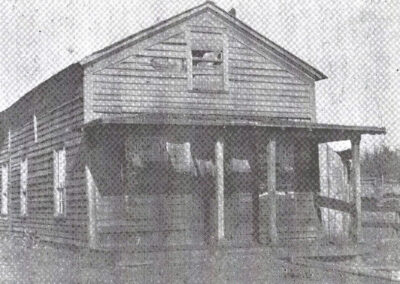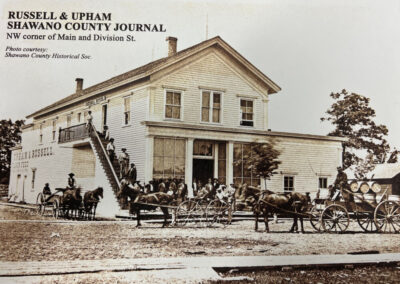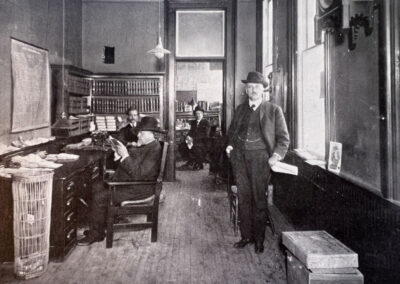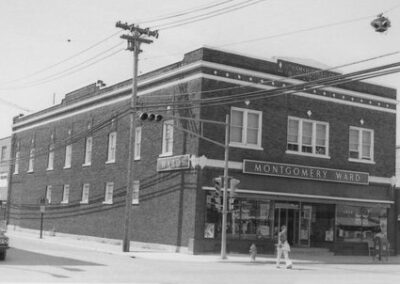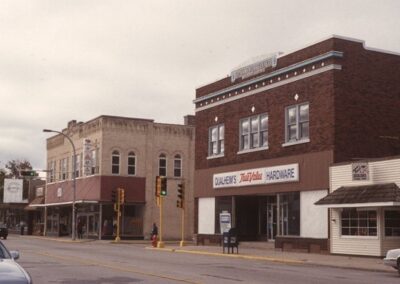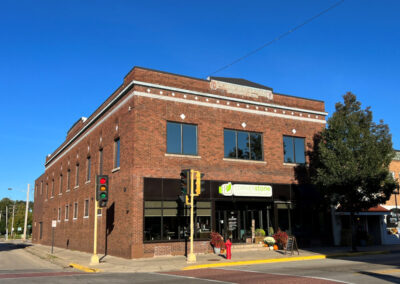Location
Photo Gallery
Office of Upham and Russell Company Store. Seated at the desk is C.M. Upham; standing is Gilbert Knapp. In the rear of the office is Robert Upham, the son of C.M. Upham. To the right is George W. Gibbs.
A Brief History
The Upham & Russell Building
153 S. Main Street
Shawano, Wisconsin
In 1858 when Charles Upham was just 21 years of age, he came to Shawano and opened a 16′ X 18′ store where the Farmers Brewery now stands. The old growth forests were untouched except for the little settlement of Shawano having less than 100 inhabitants.
There was only an Indian trail from New London to Shawano. The nearest railroad was at Fond du Lac. Charles Upham walked the 32 miles from New London while the provisions and dry goods for hist store were poled on the river to Shawano by Indians. He chose Shawano for his business because of its strategic position on the Wolf River – it was a natural point for supplying loggers operating north of Shawano and driving logs on the Wolf to Oshkosh.
When this first store became too small, he moved first to what was later called the Dave Black home on the NW corner of Main and Hill Streets. Upham then moved to the NW corner of Main and Division Streets. In 1870 a partnership of Upham and Russell was formed, the latter being Upham’s brother-in-law. In 1884 the partnership merged into a corporation with the addition of George Gibbs and R.W. Jackson.
At Upham’s 50th anniversary in business, the 288 square feet of floor space of the first store became 52,064 square feet including the general store, meat market, hay barn, grain and potato elevator, coal shafts, the men’s clothing store called The Hub and the hardware store at the corner of Main and Green Bay streets, later known as the Farmer’s Hardware and in 1973 as the Sperberg Brothers Standard Service station. C.M. Upham’s business was continued by his son, Robert Upham.
Built in 1920, the second Upham-Russell building on the NW corner of Main and Division still stands today.
Charles Upham’s involvement in the community:
- 1861 Postmaster of Shawano County.
- 1862 Purchased interest in the Shawano County Journal from Masonic Brother Myron McCord and became its editor.
- 1865 Purchased a hotel at the northeast corner of Main and Green Bay Street.
- 1868 Founder of Shawano Masonic Lodge #170.
- 1875 Elected Shawano’s second mayor (Shawano’s first Mayor was his Brother D.H. Pulcifer).
- 1876 Temperance Law fights in the city council became so heated three aldermen and Mayor Upham resigned.
- 1881 Organizer of Shawano Water and Power and River Improvement Company. The company built a dam across the Wolf for waterpower purposes.
- 1893 Became the owner of water powered gristmill where the Shawano Paper Mill now stands.
- 1900 Reorganized Shawano County Bank as Shawano first national bank chartered under the laws of the United States. He was president of it and it’s successor First National Bank for twenty years.
Businesses in the Upham & Russell Building include:
- Upham and Russell
- Montgomery-Ward
- Qualheim’s True Value Hardware
- Cornerstone Chiropractic and Wellness
From the 1999 National Register of Historic Places Registration application:
Although contemporary accounts indicate that this building’s construction in 1920 incorporated part of its predecessor, a mid nineteenth century Greek Revival store show no evidence of this 1871 earlier building is apparent. This dark-red mottled brick building with three wide bays is located on the northwest corner of South Main Street and Division Street, where its visual impact is significant. The city’s oldest historic retailer, Upham and Russell housed their dry goods, clothing and other businesses here until 1940, after which time the business housed a Montgomery Ward outlet. With the exception of obscuring the original transom light and signage area, and boarding up a series of small windows along the south-facing facade, this building appears substantially unaltered. The upper terminus of the primary facade is marked by a pressed-metal sign plate announcing the original business’s name and date of commencement. This sign plate is adorned on either side by a raised, elongated diamond, a motif repeated across both the primary and south-facing facades. Immediately below this sign plate is a simple molded projecting cornice and a flush-set beltcourse underneath; both comice and beltcourse span both of the visible facades. Across the primary facade, the area between these two horizontal members is inset with a series of evenly-spaced equilateral diamonds, which extend across the facade’s length. This space is left unadorned on the south-facing facade.
The second floor windows on both facades consist of one-over-one, double-hung wood-clad glazing, all of which are original. On the primary facade these windows are paired in the openings to either side and tripled at the center bay; on the south-facing facade these are all set singly. Each window or set of windows rests on a plain, smooth-faced concrete sill and is surmounted by a decorative motif consisting of a slightly raised brick panel extending the width of the window or window grouping and inset by a single contrasting-colored equilateral diamond.
The first floor of the south-facing facade has smaller window openings, approximately one-half the size and aligned directly with those above; these are currently obscured by boards. The first floor of the primary facade has two large display windows on either side of a central recessed single-door entry; all of the display windows rest upon original brick bulkheads. The door itself consists of a modem, but unobtrusive single aluminum frame door set into a transom and sidelights of similar materials. The doorway is framed by two narrower display windows, which are joined at a right angles to larger windows that extend to the street facade. The storefront is supported by interior, plain, round columns, and although the glass may be non historic, the storefront design itself appears to be original. The entry is accessed by two wide concrete steps, which elevate the storefront above the sidewalk level. The transom area above the storefront is covered by siding material and a larger
non-historic sign.
CHARLES M. UPHAM – Since the pioneer days of Wisconsin, the Upham family has furnished some of the most notable figures in public and commercial affairs of the state. To those familiar with political history, perhaps the name which would first come to mind would be that of former Governor William H. Upham, soldier, manufacturer, and banker at Marshfield, since 1878, and Governor of Wisconsin from 1895 to 1897. Of a second generation of the same family, is Frederick William Upham, one of the foremost business men of Chicago, and a national political leader. Concerning these men and other representatives of the family, appropriate mention is made on other pages of this work. For the present consideration is introdnced the remarkable career of Charles M. Upham, who for fifty-five years has been engaged in business at Shawano, in Shawano county.
Charles M. Upham grew up to manhood in southern Wisconsin, and his first business experience was at Weyauwega, in Waupaca county, where his brother Nathan had opened a store. A few years later, they determined to extend their business to Shawano, and it was for the purpose of opening up the establishment that Charles M. Upham made the trip across country, previously described in 1872. Mr. Upham married Julia Parsons, of Racine. Their two children are: Robert A., and Sarah B. Mr. Upham has been affiliated with the Masonic order for a great many years and though he keeps up his dues, seldom visits the lodge rooms any more. For a number of years, he had extensive building holdings in Marshfield, the home of his brother, Governor Upham, but sold-out his property there a few years ago, and practically all his interests are concentrated in Shawano, and vicinity.
SOURCE (Google Books): “Wisconsin: Its Story and Biography, 1848-1913” Volume 5, pages 1163-1166, by Ellis Baker Usher.

